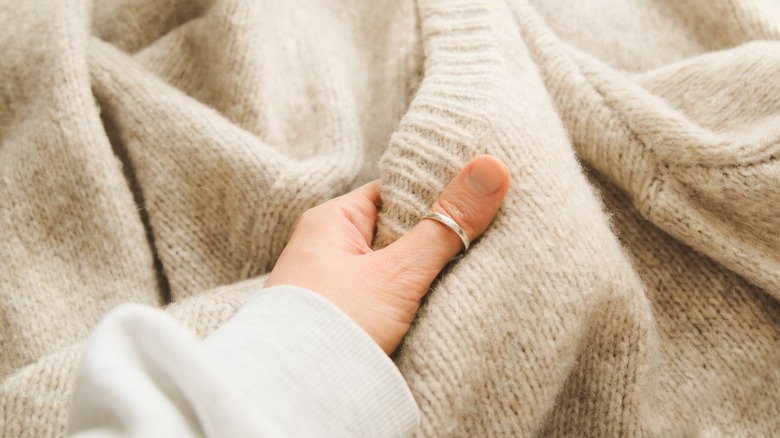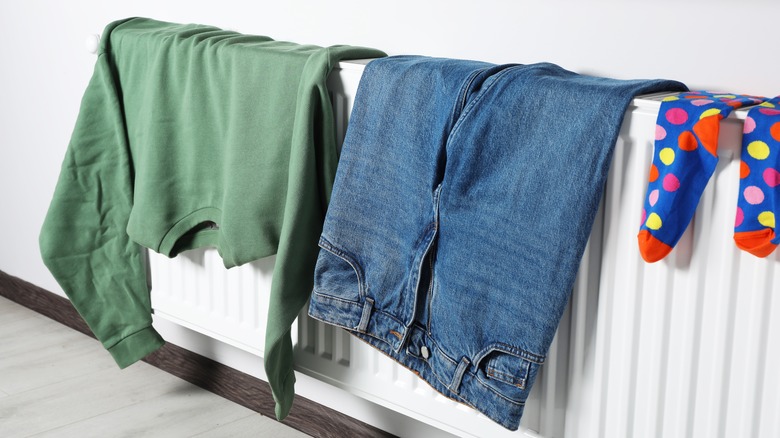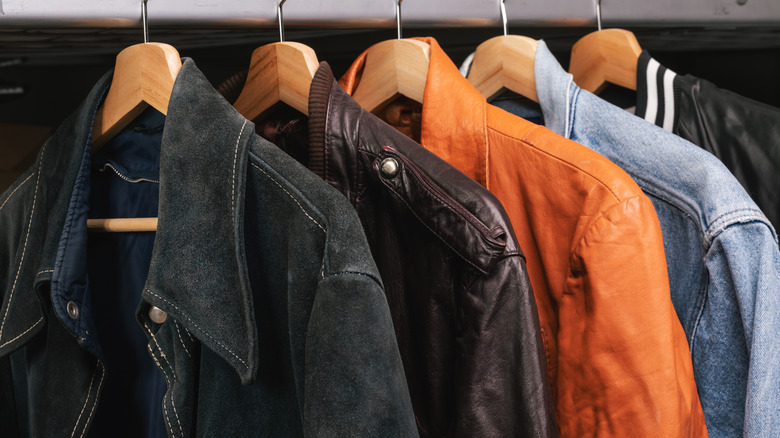Genius Tips To Take Good Care Of Your Fall Clothes
Each year, when fall approaches, there's a certain joy in breaking out all those flannels, sweaters, and jackets. It's a cozy season of amazing textures and layered outfits. However, fall clothes tend to require different care than spring and summer items. Even clothes that are warm and heavy can be surprisingly delicate. You can't simply toss everything in the washer and dryer and hope for the best.
The good news is that as long as you clean and handle them with care, your favorite fall garments should last you a good, long time. As you pull autumnal pieces out of your closet or storage, start by checking their care labels. It's always important to follow the instructions on your clothing. For example, cashmere is often marked "hand wash" or "dry clean only," while knits may be machine washable in cold water.
And, if you're not sure what those laundry symbols mean, Whirlpool's printable guide is handy. However, even with those care instructions in mind, some additional tips will help your fall clothing last for years to come.
Use the right settings
Whether you do laundry at home or in a shared facility, it's crucial to know which settings the machine offers and to use them to your advantage. Hot water and high heat are the enemies of many fall items. They can fade colors, shrink fabrics, and generally just wear your clothes out faster. Unless the care instructions specify otherwise, opt for warm or cold washes for your fall laundry.
If you're in doubt, cold water is usually the safest bet for fall clothes. Knits tend to fare best in cold water since heat can fray the yarn. However, warm and hot water does a better job of removing dirt, so these settings can be useful for heavily soiled items. In addition to temperature, consider speed and rinse settings too. Try a gentle setting to reduce snags in sweaters while an extra rinse can help get detergent residue out of thick, heavy items.
Mesh laundry bags are a great way to protect delicate knits, embellished sweaters, and anything else that could use a little more care.
Sort with care
Fall is full of luxurious textures, from fuzzy-soft sweaters to heavy jeans, and bold colors. However, to get the best fall laundry results, make sure to separate your clothes carefully by both material and color. Rough textures, buttons, and zippers can catch on and damage your more delicate items. Materials like flannel can spread lint to other items. So, think "like with like" as you separate your fall laundry: Wash heavy coats together, for instance. This will also help you get the settings right since similar fabrics can be washed using similar settings.
It's equally important to separate by color. The "no white after Labor Day" rule may be outdated, but the "no white with colors in the washer" rule definitely isn't. Separate dark, bright, and light clothing, so the colors don't transfer, and keep in mind that red clothing is the most likely to stain other items. If you have a lot of rich reds and burgundies in your fall wardrobe, consider washing those in their own separate load.
Don't over-wash
If you wash each item too frequently, you'll wear out your fall clothes much faster. In fact, your outer layers, like heavy sweaters and cardigans, may only need to be washed a few times per season. They also tend to benefit from smaller amounts of detergent, since thick clothing can easily pick up residue. The items that come into contact with your skin most often will need the most frequent washing, especially if they've touched sweat or makeup. Scarves, gloves, and hats will benefit from a wash every few wears.
Meanwhile, fall coats may not need to be washed more than a couple of times a season, unless something gets spilled on them of course. Sweaters and hoodies, on the other hand, may require more frequent washing. However, if you tend to wear a layer beneath them, like a long-sleeved t-shirt, you can often toss that in the wash and wait on the rest. Wool is an exception to many cleaning expectations. Since it acts as a natural dirt and moisture-repellent, you can wash wool even less frequently than other materials.
Avoid the dryer
Though heavy fall fabrics can take longer to dry, it's always best to air dry if you can. Your warm clothes can easily shrink in a dryer, and it's incredibly disappointing when a cozy, oversized sweater comes out tiny. Dryers also make your clothes wear out faster. That's why there's so much lint in a dryer: The process pulls fibers from your clothes. Over time, this can lead to thinning and holes, which is another good reason to keep your cozy clothes out of the dryer.
Of course, it may be too cold and wet to dry things outside. However, laundry drying racks are inexpensive and tend to fit well in a corner of your home. Since you aren't washing your fall clothes too frequently, you won't need to have the drying rack out very often either. You can also hang things from your shower curtain rod if you have just a few, smaller items to dry.
That said, some clothes do benefit from a tumble dry. Down jackets, for example, often need to be dried so they can become fluffy again. A couple of tennis balls in the dryer will keep the down filling evenly distributed.
Invest in special care
While you can get great results at home with these tips, a few items will always need special care. Double-check the tags of any clothing made from specialty materials like cashmere, leather, or suede to see if they need dry cleaning or similar professional care. These materials are easy to damage at home, so it's especially valuable to follow the instructions.
With that in mind, you may actually be able to take care of some "dry clean only" items at home. Home dry clean kits let you use your dryer to clean delicate items. These won't work on every material, but for simple things like sweaters, they can do the trick and save you some time and money in the process.
However, if an item is particularly unique or has sentimental value, consider letting the experts care for it. With a little extra care and attention, your favorite fall garments will last you for years to come. And, when the cold season comes to an end, remember to clean everything before putting it away, so your fall clothes are ready to wear when the seasons change again.





